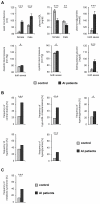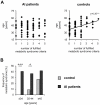Increased prevalence of metabolic syndrome in patients with acne inversa
- PMID: 22359634
- PMCID: PMC3281019
- DOI: 10.1371/journal.pone.0031810
Increased prevalence of metabolic syndrome in patients with acne inversa
Abstract
Background: Acne inversa (AI; also designated as Hidradenitis suppurativa) is a common chronic inflammatory skin disease, localized in the axillary, inguinal and perianal skin areas that causes painful, fistulating sinuses with malodorous purulence and scars. Several chronic inflammatory diseases are associated with the metabolic syndrome and its consequences including arteriosclerosis, coronary heart disease, myocardial infraction, and stroke. So far, the association of AI with systemic metabolic alterations is largely unexplored.
Methods and findings: A hospital-based case-control study in 80 AI patients and 100 age- and sex-matched control participants was carried out. The prevalence of central obesity (odds ratio 5.88), hypertriglyceridemia (odds ratio 2.24), hypo-HDL-cholesterolemia (odds ratio 4.56), and hyperglycemia (odds ratio 4.09) in AI patients was significantly higher than in controls. Furthermore, the metabolic syndrome, previously defined as the presence of at least three of the five alterations listed above, was more common in those patients compared to controls (40.0% versus 13.0%; odds ratio 4.46, 95% confidence interval 2.02 to 9.96; P<0.001). AI patients with metabolic syndrome also had more pronounced metabolic alterations than controls with metabolic syndrome. Interestingly, there was no correlation between the severity or duration of the disease and the levels of respective parameters or the number of criteria defining the metabolic syndrome. Rather, the metabolic syndrome was observed in a disproportionately high percentage of young AI patients.
Conclusions: This study shows for the first time that AI patients have a high prevalence of the metabolic syndrome and all of its criteria. It further suggests that the inflammation present in AI patients does not have a major impact on the development of metabolic alterations. Instead, evidence is given for a role of metabolic alterations in the development of AI. We recommend monitoring of AI patients in order to correct their modifiable cardiovascular risk factors.
Conflict of interest statement
Figures





Similar articles
-
Hidradenitis suppurativa/Acne inversa: an endocrine skin disorder?Rev Endocr Metab Disord. 2016 Sep;17(3):335-341. doi: 10.1007/s11154-016-9366-z. Rev Endocr Metab Disord. 2016. PMID: 27294593 Review.
-
The prevalence of metabolic syndrome in patients with hidradenitis suppurativa.J Am Acad Dermatol. 2014 Apr;70(4):699-703. doi: 10.1016/j.jaad.2013.11.014. Epub 2014 Jan 13. J Am Acad Dermatol. 2014. PMID: 24433875
-
Lipocalin-2 is expressed by activated granulocytes and keratinocytes in affected skin and reflects disease activity in acne inversa/hidradenitis suppurativa.Br J Dermatol. 2017 Nov;177(5):1385-1393. doi: 10.1111/bjd.15424. Epub 2017 Sep 19. Br J Dermatol. 2017. PMID: 28256718
-
MMP8 Is Increased in Lesions and Blood of Acne Inversa Patients: A Potential Link to Skin Destruction and Metabolic Alterations.Mediators Inflamm. 2016;2016:4097574. doi: 10.1155/2016/4097574. Epub 2016 Oct 23. Mediators Inflamm. 2016. PMID: 27843200 Free PMC article.
-
[Acne inversa/hidradenitis suppurativa: A challenge for the future].Hautarzt. 2017 Dec;68(12):994-998. doi: 10.1007/s00105-017-4079-0. Hautarzt. 2017. PMID: 29110042 Review. German.
Cited by
-
Hidradenitis suppurativa and its association with obesity, smoking, and diabetes mellitus: A systematic review and meta-analysis.Int Wound J. 2024 Sep;21(9):e70035. doi: 10.1111/iwj.70035. Int Wound J. 2024. PMID: 39267324 Free PMC article.
-
Hidradenitis suppurativa/Acne inversa: an endocrine skin disorder?Rev Endocr Metab Disord. 2016 Sep;17(3):335-341. doi: 10.1007/s11154-016-9366-z. Rev Endocr Metab Disord. 2016. PMID: 27294593 Review.
-
Metabolic syndrome and skin: psoriasis and beyond.Indian J Dermatol. 2013 Jul;58(4):299-305. doi: 10.4103/0019-5154.113950. Indian J Dermatol. 2013. PMID: 23919003 Free PMC article.
-
Acne inversa (Hidradenitis suppurativa): A review with a focus on pathogenesis and treatment.Indian Dermatol Online J. 2013 Jan;4(1):2-11. doi: 10.4103/2229-5178.105454. Indian Dermatol Online J. 2013. PMID: 23439959 Free PMC article.
-
Delayed Diagnosis of Hidradenitis Suppurativa and Its Effect on Patients and Healthcare System.Dermatology. 2020;236(5):421-430. doi: 10.1159/000508787. Epub 2020 Jul 1. Dermatology. 2020. PMID: 32610312 Free PMC article.
References
-
- Jemec GB, Heidenheim M, Nielsen NH. The prevalence of hidradenitis suppurativa and its potential precursor lesions. J Am Acad Dermatol. 1996;35:191–194. - PubMed
-
- Revuz JE, Canoui-Poitrine F, Wolkenstein P, Viallette C, Gabison G, et al. Prevalence and factors associated with hidradenitis suppurativa: results from two case-control studies. J Am Acad Dermatol. 2008;59:596–601. - PubMed
-
- Meixner D, Schneider S, Krause M, Sterry W. Acne inversa. J Dtsch Dermatol Ges. 2008;6:189–196. - PubMed
-
- Alikhan A, Lynch PJ, Eisen DB. Hidradenitis suppurativa: a comprehensive review. J Am Acad Dermatol. 2009;60:539–561; quiz 562–533. - PubMed
-
- von Laffert M, Stadie V, Wohlrab J, Marsch WC. Hidradenitis suppurativa/acne inversa: bilocated epithelial hyperplasia with very different sequelae. Br J Dermatol. 2011;164:367–371. - PubMed
MeSH terms
LinkOut - more resources
Full Text Sources
Other Literature Sources
Medical

